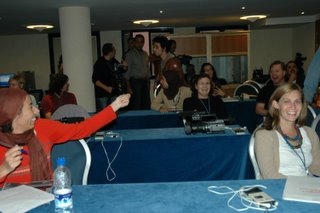NOTES ON EDITING from a class with Hakim Belabbes
 Beats
BeatsA beat is a shift in emotional tone that occurs in the scene and equally reflects in the audience. If there is just a small change in a scene, the audience shifts in relation to the story or image just a little. Bill Viola’s “Hatsu Yume” is a good work to look at when trying to identify where beats are. The film seems to have one fluid beat, your impression is changed slowly and constantly by the piece, but there are moments, naturally occurring sometimes within the organism of the shot that create these slight shifts.
I’m interested in how you wrote the scenes in your screenwriting exercise, because I think, maybe, instinctively, you were working according to beats? Think about how you wrote them and what the guidelines were. A lot of times I think I write what is not essential, I write until I figure out what is. I ask myself what triggered a certain image or word in order to find what is essential.
Student : Justement, j’avais pas cette notion de “Beats,” battement ou rythme...I didn't have this notion of beats or rhythm. I used to work in a structured way, but in this case I worked with a much more instinctive method. I can feel the strong points in my script, but I can't feel the structure as well.
Mick: I would say that the rhythm already exists in a scene as it is written and the job of the editor is to find that rhythm and bring it out.
Hakim: I would say that the beat happens earlier than that, even where there is no editing, there is a rhythm and beat in the writing, and these will help you find the structure. Everything is based on the writing. Even people like Kiarostami, who only write a page or two before they start shooting, have to put something down on paper first.
Subtleties of Editing
A film should have a notion of DNA; as in the body, whether it’s a finger cell, or a liver cell, it has a layout for the entire body, a plan for the entire organism.
You see it a lot; there is a problem with a shot and an editor thinks he can just put in a cut-away. Sometimes people cut to hands or lamps in the room, just to cut back. They’re so afraid of the jump cut; they think they have to make it smooth. Why not go to the lamp?
Because you’re disrupting anything I’m feeling at that point!
Visualize this scene in "Sideways" with one moment standing out. The shooting is utilitarian, medium close-up, medium close-up, medium close-up, medium close-up, then close-up, and another close-up. Then the director does something so subtle, he moves in on Miles. It’s something so imperceptible, and it’s asking, “What are you going to do Miles?” Then, directly following, there is the sudden contact of the hand. This moment breaks the utilitarian pattern and it stands out. It creates a subconscious emotional effect.
No one can teach you how to edit, anything, ever. The one thing that no one can teach you, and that all of you will find in your own rhythm, is the rhythm of editing.

0 Comments:
Post a Comment
<< Home